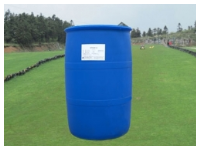Hydrophilic (oleophobic) hydrocarbon group surfactants are generally used in aquatic products. When the surfactant molecules enter the aqueous solution, the oleophobic group of the surfactant tends to escape from the aqueous phase in order to reduce the contact with the water as much as possible. However, due to the existence of the hydrophilic group in the surfactant molecules, it cannot escape from the aqueous phase completely. The result of the equilibrium is that the surfactant molecules in the solution It is enriched on the surface, that is, the lipophilic group is toward the air, and the hydrophilic group is inserted into the water phase, so the interface formed by the original water and air is gradually replaced by the interface formed by the lipophilic group and air of the surfactant, the surface tension of water is reduced, and the air is more likely to enter the water body.
The density of the surface water is lower than that of the bottom water because the micelle can not be formed due to the low concentration. Under the dispersion of surfactant, the upper and lower water circulates to bring air into the bottom of the pool.

Especially in the daytime, the oxygen content in the water layer above the compensation depth of the aquaculture water body is supersaturated due to the photosynthesis of phytoplankton, while the oxygen content in the water layer below the compensation concentration, especially in the bottom water layer, is too low or even anaerobic due to the oxygen consumption of biological respiration, organic matter oxidation, etc.
After the surfactant is sprinkled into the aquaculture water body in the daytime, the surfactant begins to distribute in the upper layer of the aquaculture water body, which makes the density of the upper layer of the aquaculture water body increase, will drive the oxygen rich water in the upper layer to move to the lower layer of the aquaculture water body, will cause convection in the upper and lower layers of the whole aquaculture water body, increase the oxygen content of the bottom water body, and reduce the deterioration of the water quality and bottom material in the lower layer. A kind of
In the high-density aquaculture water body, a large amount of feed is usually put into the water body to be digested by aquatic animals and then a large amount of waste is discharged. After microbial decomposition, plankton metabolism and other factors, oil film is formed on the surface of the water body to block the air from contacting with the water body and increase the surface tension of the water body. The surfactant can make the oil film gradually shrink into oil beads, which are separated, rolled and concentrated to the air outlet by water flow. When the amount of surfactant is large, it can be emulsified and suspended in the water body in the form of particles.
The decrease of water surface tension makes the oxygen in the air easier to carry on in the water body, accelerates the dissolution of oxygen in the water body, and the increase of transparency enhances the photosynthesis of algae, so as to increase the oxygen content in the water body.
At present, surfactants can be used as bactericides and disinfectants in the aquatic industry, and some surfactants can be used in the improvement of substrate, but there are few reports about the influence of surfactants on dissolved oxygen in water.
There are many kinds of surfactants, with more than 20000 brands and 12 million tons of output. They are widely used in various fields of industry, agriculture and people's life. They are called "industrial monosodium glutamate". There are few papers about the application of surfactants in aquaculture.
Surfactant is a kind of substance with fixed hydrophilic and lipophilic groups, which can be oriented on the surface of the solution and make the surface tension drop significantly. The molecular structure of surfactant is amphiphilic: one end is hydrophilic group, the other end is hydrophobic group; hydrophilic group is usually polar group, such as carboxylic acid, sulfonic acid, sulfuric acid, amino group or amine group and its salt, but also hydroxyl group, acylamino group, ether bond, etc.; while hydrophobic group is often nonpolar hydrocarbon chain, such as hydrocarbon chain with more than 8 carbon atoms.